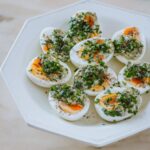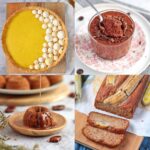Imagine a Christmas brimming with delectable treats, each bite a joyous explosion of flavor, yet crafted with meticulous care to exclude eggs. This guide unveils the secrets to creating stunning, egg-free festive delights, from light and airy cakes to rich, decadent puddings. We’ll explore innovative baking techniques, adapting classic recipes to suit diverse dietary needs while maintaining the festive spirit and visual appeal. Prepare to be inspired by a world of possibilities, where deliciousness meets inclusivity.
Through detailed recipes, step-by-step instructions, and visually captivating descriptions, we’ll empower you to bake magnificent egg-free Christmas cookies, cakes, and puddings. Learn to master egg replacements, understand the structural impact of egg omission, and discover creative decoration techniques. We’ll also address crucial dietary considerations, ensuring your creations are not only delicious but also safe and allergy-conscious.
Egg-Free Festive Baking Techniques
Creating delightful egg-free Christmas treats requires understanding how eggs contribute to baked goods and employing effective substitutes to mimic their functionalities. Eggs provide structure, leavening, moisture, and richness. Mastering egg-free techniques allows for delicious and inclusive holiday baking.
Achieving Light and Fluffy Texture in Egg-Free Christmas Cakes
Several methods can create light and airy egg-free cakes. The key is to replace the binding and leavening properties of eggs effectively.
- Method 1: Using Applesauce and Baking Powder. Applesauce adds moisture and a slight sweetness, while baking powder provides lift. A recipe might call for 1/4 cup of applesauce and 1 teaspoon of baking powder per large egg replaced. The applesauce contributes to a tender crumb, while the baking powder ensures the cake rises nicely. Imagine a moist, fluffy cake with a subtle apple-like aroma, perfectly complementing the festive spices.
- Method 2: Employing Mashed Banana and Vinegar. Mashed banana offers moisture and sweetness, similar to applesauce. Vinegar reacts with baking soda (often used in conjunction with baking powder) to create carbon dioxide bubbles, providing lift. A typical substitution might involve 1/2 cup mashed banana and 1/2 teaspoon of vinegar per large egg. The result is a cake with a slightly sweet banana flavor, a moist texture, and a good rise. Picture a golden-brown cake with a soft, slightly speckled crumb, reminiscent of a classic banana bread but with a distinctly festive flavor profile.
- Method 3: Flaxseed Meal or Chia Seeds and Water. Flaxseed meal or chia seeds, when mixed with water, form a gel-like substance that acts as a binder. This method is excellent for providing structure. One tablespoon of flaxseed meal or chia seeds mixed with three tablespoons of water can replace one egg. The resulting cake maintains structural integrity without the need for excessive leavening agents. Envision a dense but moist cake, perfect for those who prefer a slightly richer, more substantial texture, showcasing the deep flavors of the spices and fruits within.
Egg-Free Meringue Alternatives
Creating a stable egg-free meringue presents a significant challenge, as egg whites provide the structure and volume. Traditional meringues rely heavily on the protein in egg whites for their characteristic airy texture. However, there are visual and textural alternatives.
- Aquafaba Meringues: Aquafaba, the liquid from canned chickpeas, can be whipped into a meringue-like foam. While it won’t achieve the exact same texture as an egg white meringue, it provides a surprisingly good substitute for vegan desserts. The resulting meringue will be less glossy and potentially slightly less stable, but still visually appealing and capable of holding its shape for many applications. Imagine a slightly less crisp meringue, perhaps more akin to a delicate cloud than a perfectly formed peak.
- Alternative Methods: Focus on achieving visual similarity through techniques like using a stiffly whipped coconut cream or a carefully layered mousse-like texture created with plant-based alternatives, rather than attempting to replicate a traditional meringue exactly. These alternatives might not have the same delicate, airy texture, but can still create a visually impressive and delicious result. Think of a creamy, elegant dessert that incorporates the festive colors and flavors, even without the airy lightness of a meringue.
Structural Integrity in Egg-Free Festive Treats
Omitting eggs significantly impacts the structural integrity of many festive treats, particularly cookies and brownies. Eggs act as a binding agent, holding the ingredients together.
- Cookies: In egg-free cookies, using a combination of binding agents like applesauce, mashed banana, or flaxseed meal can compensate for the missing egg. Increasing the amount of flour slightly might also be necessary to provide additional structure. Imagine perfectly formed cookies that maintain their shape while still possessing a delightfully soft and chewy texture.
- Brownies: For egg-free brownies, the focus shifts to achieving a fudgy texture through the use of ingredients like oil and melted chocolate. Using a slightly higher ratio of dry ingredients can help compensate for the loss of binding. Envision dense, rich, and intensely chocolatey brownies that are deliciously decadent despite lacking eggs.
Popular Egg-Free Festive Recipes

This section explores delightful egg-free recipes perfect for a festive celebration, ensuring everyone can enjoy the deliciousness of Christmas baking regardless of dietary restrictions. These recipes focus on achieving rich textures and flavors without compromising on the traditional festive spirit.
Egg-Free Gingerbread Cookies
These delightfully spiced gingerbread cookies offer a warm, comforting aroma and a satisfyingly crisp texture, all without using eggs. The flaxseed meal acts as a binding agent, creating a cohesive dough that holds its shape beautifully.
| Ingredients | Quantities | Instructions | Notes |
|---|---|---|---|
| All-purpose flour | 3 cups | Whisk together dry ingredients. | Use gluten-free blend for a gluten-free option. |
| Baking soda | 1 teaspoon | Combine wet ingredients in a separate bowl. | Ensure baking soda is fresh for optimal leavening. |
| Ground ginger | 2 tablespoons | Gradually add wet ingredients to dry, mixing until just combined. | Adjust ginger quantity to taste preference. |
| Ground cinnamon | 1 tablespoon | Chill the dough for at least 30 minutes. | Chilling prevents spreading during baking. |
| Ground cloves | ½ teaspoon | Roll out dough to desired thickness and cut out shapes. | Use cookie cutters for festive shapes. |
| Molasses | ½ cup | Bake at 375°F (190°C) for 8-10 minutes, or until edges are lightly golden. | Baking time may vary depending on oven and cookie thickness. |
| Brown sugar | 1 cup | Let cookies cool completely on a wire rack before decorating. | Decorate with icing, sprinkles, or other festive elements. |
| Vegetable oil | ½ cup | ||
| Water | ½ cup | ||
| Flaxseed meal | 1 tablespoon + 2 tablespoons water | Mix flaxseed meal and water, let sit for 5 minutes to form a gel. Add to wet ingredients. | Flax egg replaces the binding properties of eggs. |
Egg-Free Christmas Pudding
This rich and moist Christmas pudding relies on applesauce and a combination of liquids to achieve its decadent texture without the use of eggs. The result is a delightfully moist and flavorful pudding that’s perfect for a festive celebration. The addition of warming spices creates a comforting and deeply satisfying dessert.
The key to a moist egg-free Christmas pudding is the balance of liquids. Too little, and the pudding will be dry; too much, and it will be soggy. Start with the recipe’s suggested quantities and adjust slightly based on the moisture content of your ingredients. If your mixture seems too dry, add a tablespoon or two of extra liquid (water, fruit juice, or even a little more applesauce). If it seems too wet, add a tablespoon of flour at a time until you reach the desired consistency.
Egg-Free Fudge
This versatile recipe allows for a variety of delicious flavor profiles. The base fudge is creamy and rich, providing the perfect canvas for exciting additions.
Peppermint Fudge
Imagine a rich, creamy fudge speckled with bright red and white peppermint candy pieces. The cool peppermint flavor cuts through the richness of the fudge, creating a delightful contrast. A dusting of crushed candy canes on top adds a festive touch, visually appealing with a vibrant red and white swirl against the smooth, creamy white base.
Chocolate Orange Fudge
This variation boasts a vibrant, deep orange color from the zest and juice of fresh oranges. Chunks of dark chocolate are folded into the creamy base, adding pockets of intense chocolate flavor that complement the bright citrus notes. The visual contrast between the deep brown chocolate and the bright orange is striking, offering a festive and delicious treat.
Adapting Traditional Recipes for Egg-Free Diets
Adapting beloved Christmas recipes to be egg-free requires understanding the multifaceted roles eggs play in baking and employing suitable substitutes to maintain the desired texture, taste, and shelf life. This involves careful consideration of each ingredient’s function and strategic replacement to achieve a satisfying result comparable to the original recipe.
Egg-free baking necessitates a deep understanding of egg function in different recipes. Eggs act as binders, leaveners, emulsifiers, and moisture providers. Replacing them effectively involves selecting substitutes that mimic these specific roles. Failure to do so can result in dry, crumbly, or otherwise unappealing baked goods.
Fruitcake Adaptation
Traditional fruitcake relies on eggs for binding and moisture. To create an egg-free version, replace the eggs with a combination of applesauce and flaxseed meal. Applesauce provides moisture and a slight sweetness, while flaxseed meal, when mixed with water, creates a gel-like consistency that acts as a binder. The ratio will depend on the original recipe, but a general guideline is to substitute one large egg with 1/4 cup applesauce and 1 tablespoon of flaxseed meal mixed with 3 tablespoons of water. The resulting fruitcake might be slightly denser than the traditional version, but the rich fruit flavors will still shine through. The shelf life may be slightly reduced, so storing it in an airtight container in a cool, dark place is recommended.
Shortbread Adaptation
Shortbread, known for its delicate crumbly texture, relies on eggs for binding and richness. In an egg-free adaptation, the eggs can be omitted entirely, resulting in a slightly drier but equally delicious shortbread. To compensate for the lost moisture and richness, increase the amount of butter slightly and consider adding a teaspoon of vanilla extract to enhance the flavor profile. The texture will be more crumbly, which some may find preferable. The shelf life should remain comparable to the traditional version if stored properly.
Gingerbread Adaptation
Gingerbread often uses eggs for binding and moisture, contributing to its characteristic chewy texture. For an egg-free version, a combination of applesauce and mashed banana can be used. Applesauce provides moisture, while mashed banana adds sweetness and helps bind the ingredients. The ratio should be adjusted depending on the recipe, but a good starting point is to replace one egg with 1/4 cup applesauce and 1/4 cup mashed banana. The resulting gingerbread might be slightly less chewy than the original, but the spices will still be prominent. Consider adding a tablespoon of molasses for extra moisture and depth of flavor. Storage in an airtight container is essential to maintain freshness.
Impact of Egg Removal on Festive Treats
Removing eggs from traditional recipes can affect the taste, texture, and shelf life of festive treats. The absence of eggs can lead to a drier texture in cakes and cookies, a less rich flavor profile, and a potentially shorter shelf life due to reduced binding and moisture retention. However, strategic substitutions, as demonstrated above, can mitigate these negative effects. The key is to understand the specific function of the egg in each recipe and choose appropriate replacements that mimic its properties. For instance, using applesauce or mashed banana can replicate the moisture and binding properties of eggs, while flaxseed meal can create a gel-like structure for binding. Careful attention to ingredient ratios and baking times is crucial for success.
Egg Substitution Techniques
The method for substituting eggs depends on their function in the recipe. When eggs act primarily as a binder (as in cookies or cakes), flaxseed meal or applesauce are effective substitutes. For leavening (as in some cakes), baking powder or baking soda, combined with an acidic ingredient like vinegar or lemon juice, can provide lift. When eggs serve as an emulsifier (as in some frostings or sauces), a combination of oil and a non-dairy milk alternative can create a similar effect. The specific ratio of substitute to egg will vary depending on the recipe, but testing and adjusting are often necessary to achieve the desired outcome. For instance, one large egg can be replaced with 1 tablespoon of flaxseed meal mixed with 3 tablespoons of water, or 1/4 cup of applesauce, or a combination of both.
This holiday season, let your kitchen become a haven of festive cheer, where everyone can partake in the joy of delicious treats. By mastering egg-free baking techniques and embracing creative adaptations, you can craft a Christmas spread that’s both inclusive and unforgettable. From the vibrant colors of decorated cookies to the rich aromas of spiced puddings, each creation tells a story of thoughtful preparation and boundless festive spirit. The joy of sharing these delectable treats, knowing they’re accessible to all, elevates the holiday experience to new heights. So, gather your ingredients, don your apron, and embark on a culinary adventure that will leave everyone delighted.
Essential FAQs
What are the best egg substitutes for binding in egg-free baking?
Applesauce, mashed banana, flaxseed meal, and silken tofu are excellent binding agents, each offering slightly different textural results.
Can I freeze egg-free Christmas treats?
Yes, many egg-free treats freeze well. Wrap them tightly in plastic wrap and then foil for optimal protection against freezer burn. Thaw completely before serving.
How long will egg-free Christmas cookies stay fresh?
This depends on the recipe and storage. Properly stored in an airtight container at room temperature, most egg-free cookies will stay fresh for 3-5 days.
Are there any specific concerns about shelf life for egg-free treats compared to those with eggs?
Egg-free treats may have a slightly shorter shelf life due to the absence of eggs’ natural preservative properties. Proper storage and airtight containers are crucial.


